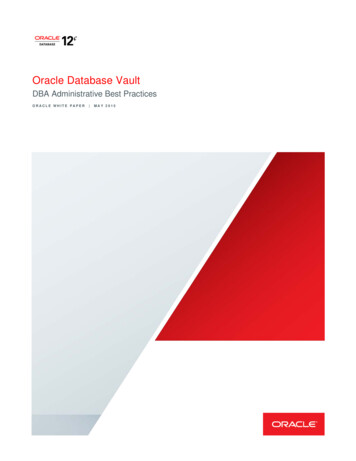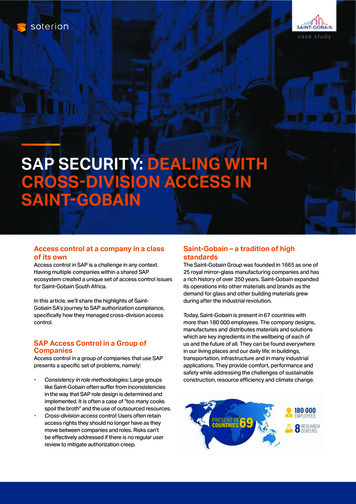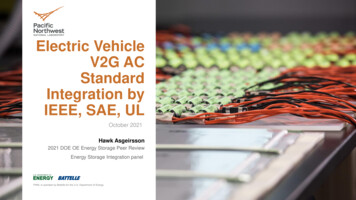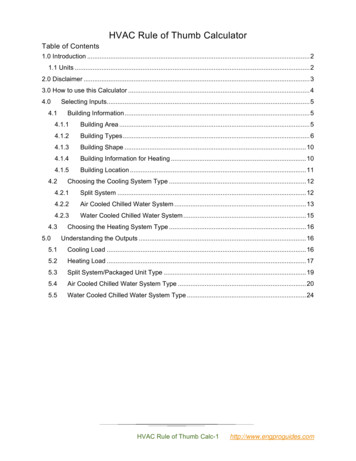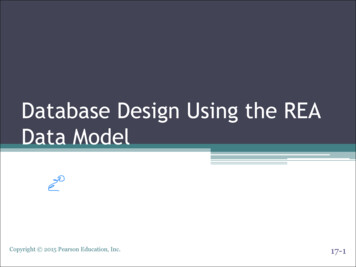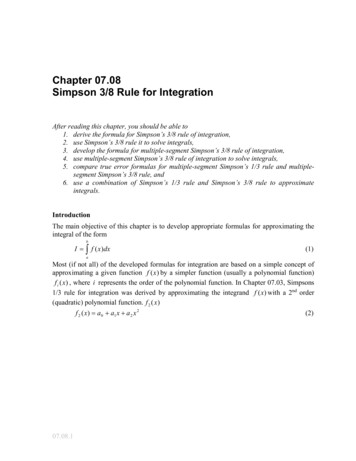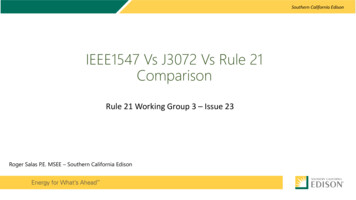
Transcription
IEEE1547 Vs J3072 Vs Rule 21ComparisonRule 21 Working Group 3 – Issue 23Roger Salas P.E. MSEE – Southern California Edison
Topics For DiscussionThis presentation is for discussion purposes only anddoes not represent a final proposal/position for SCESection V2G-AC PEV Jurisdiction/Governing Boards Scope Descriptions Conformance Tensting J3072 Area of Focus – EVSE-V2G AC Communication EVSE to V2G AC Communiction Interface Areas to Consider for Standards & V2G DeploymentSection V2G-DC PEV V2G-DC systems requirements and transition Enabling Discharing Capability2
DisclaimerSCE has collaborated with SMEs from SAE J3072 and IEEE standards on the development of this material. Theinformation provided in this material is SCE’s best understanding of the various standards which may not always fullyillustrate an accurate comparison.Further, by this presentation, SCE does not endorse the adequacy of SAE J3072 standard, testing or certification forinterconnection requirements under Rule 21. SCE simply presents the information as SCE currently understands thestandards be.SCE notes that with this investigation it became evident that there is a need for further collaboration betweenAutomotive Standards technical groups (SAE) and stationary DER technical standards group (IEEE 1547). SCE notesthat for California to be successful in the deployment of V2G systems, it will be essential for industry technical leadersfrom both vehicle and stationary systems to engage in the development or updates to relevant standards that willallow for safety interconnection of V2G systems.3
Jurisdiction or Governing BoardSurface Vehicle StandardJ3072 - 2015 EditionIEEE1547 - 2018 EditionIEEE1547.1 – 2019/2020TBDRule 21Phase I – 2017Phase II & III - 2019SAE Technical Standards BoardIEEE Technical Standards BoardCalifornia PUCUpdates: 5 year review required oras required by industry. HankMcGlynn current document leaderwill support opening for review.Updates: Every as industry requestwith approved Project (reaffirmedevery 5 years)Authorization Request from IEEESCC21Updates: PUC opens OIR based onneeds and updates completed withstakeholder participation4
Standard Scope DescriptionSurface Vehicle StandardJ3072 - 2015 EditionIEEE1547 - 2018 EditionIEEE1547.1 – 2019/2020TBDRule 21Phase I – 2017Phase II & III - 2019Establishes InterconnectionRequirements for Utility InteractiveInverter Systems which areIntegrated into a PEV (V2G-AC)Establishes Criteria andRequirements for Interconnectionof DERs with the EPS andAssociated Interfaces.Sets Interconnection, Operatingand Metering Requirements forGenerating Facilities Connected tothe gridNotes V2G-DC PEVs out of scopeFocus only on Information Exchange betweenV2G-AC PEV and EVSE as well as configurationmanagement of the onboard inverterReferenced IEEE1547 for testing criteria but doesnot follow certification requirements as require inR21 for stationary invertersRule 21 relies heavily on IEEE1547/.1Currently usingUL1741/UL1741SA5
Conformance TestingV2G AC PEV/EVSE Conformance Testing Standards*J3072 Section 4.6Standard*Performed by EVSEManufacturer orNRTL*Smart Inverter Conformance Testing StandardsRule 21UL 1741UL 1741 SAACInverterDCperformed by OSHAapproved NRTLsInterim method whileIEEE1547.1 is approvedand Incorporated to UL1741DC EnergySourceUL 1741Information Exchange: J3072*Inverter System: IEEE1547/IEEE1547.1 – 2003Performed byVehicleManufacturer* ONLY 4.6 - EVSE Authorization of PEV to DischargeIEEE1547 - 2018 EditionIEEE1547.1 – 2019/2020 TBDCertificationBy OSHAApprovedNRTLs6
J3072 Focus – EVSE to Vehicle CommunicationIllustration Source: AEYCH – Hank McGlynnInside VehicleInverter System Uses IEEE1547 2003 andassociated IEEE1547.1testing standards Performed by manufacturernot by NRTL as currentlyrequired in Rule 21 Defines requirements for theinformation that must be sharedbetween the EVSE and theroaming onboard V2G-AC PEVInverter System for the purposesof setting up the onboardinverter system for discharging atthe EVSE site. Requires the use of IEEE 2030.57
EVSE to V2G AC PEV Communication InterfaceSection 4.6 - EVSE Authorization of PEV Local Facility Information Is Passed From EVSE to V2GPEV (such as reference voltage, Max Reverse Power, etc.) PEV parameters passed from V2G to EVSE (such ascertification information, inverter system model #) EVSE Authorizes the V2G to discharge up to limitprovided by EVSE EVSE monitors and disconnects if PEV violates the limitsAreas to need standards updates Unclear as which parameter the inverter changes asresponse to EVSE received information. For example –IEEE1547 -2003 does not have a “Limit Real Power”function Unclear which reactive function is applied (max reactivepower or PF) and if it applies to both power flow directions. Unclear as to how and when the EVSE takes correctiveactions Unclear as if performance is tested along with EVSEcommunications (Does the test include that the inverteractually responded to a command sent by the EVSE?) Unclear as to how the EVSE receives the parameters to useat the site8
Areas To Consider for Standard & V2G AC Deployment J3072 Standard should be reviewed and updated to clarify codes and standardsapplicable for EVSE testing and certification requiremens J3072 Standard should independently verify V2G PEV certification Conform J3072 parameters for EVSE and Inverter System with IEEE 1547 standard Clarify the correlation between the various V2G and EVSE standards to IEEE standards J3072 (Surface Vehicle Standard) UL2594 (Standard for Electric Vehicle Supply Equipment) J2836 – Communication and Interoperability (Technical Information Report) IEEE 2030.5 J3072 standard should be updated to require EVSE to verify that all elements of theinverter system are certified to insure system are not inadvertently replaced duringvehicle maintenance including any changes to operating firmware and any inverterconfiguration filesV2G AC PEV implementation road map via SIGW-SAE Working Group to develop and provide PUC withrecommendation on implementation of V2G-AC PEV in California9
V2G DC Systems Inverter is part of the EVSE Bi-directional capable EVSE must be certified by NRTLsregardless of bi-direction activation EVSE manufacturers/NRTLs to follow labeling and listingfor EVSE equivalent to storage invertersNear Term (2019-2021)Reverse (discharging) – Conformance Testing NRTL certification using IEEE1547/IEEE1547.1 (2003) should beallowed UL1741 SA certification should not be required (allowed)Reverse Blocking – (charging only) – Conformance Testing Rule 21 Non-export AC/DC converter definition requirements Need to determine testing for mode selectionForward (charging) - Conformance Testing Not Applicable to Rule 21Transition To New Requirements ( 2021)Reverse (discharging) – Conformance Testing NRTL certification using IEEE1547 (2018)/IEEE1547.1 (2019) Allow one year from approval of IEEE1547.1 (2019) for industrydeploymentReverse Blocking – (charging only) – Conformance Testing Rule 21 Non-export AC/DC converter definition requirements Need to determine testing for mode selectionForward (charging) - Conformance Testing Not Applicable to Rule 2110
Enabling Discharging CapabilityCustomer Responsibility EVSE should be shipped with “Reverse Block”- “Forward” Only enabled Requires owner to call EVSE manufacturer OEM for temporary password (See Electric Current UL CRD forother options) Need to verify compliance with California Health and Safety Code Section 119085(b) Need to verify compliance with Account for NEC 705.6 – Equipment ApprovalInterconnection Request Owner responsible for applying for interconnection and must receive utility PTO prior to enabling the bidirectional function Owner is responsible for programming EVSE and enable bi-directional ONLY after receiving PTO11
Discussion12
Automotive Standards technical groups (SAE) and stationary DER technical standards group (IEEE 1547). SCE notes that for California to be successful in the deployment of V2G systems, it will be essential for industry technical leaders from both vehicle and stationary systems to engage in t
